“Lesson on wild and domestic animals” - Since ancient times, man began to tame and is still taming animals. Do we have anything in common with animals? Click the "Personal" tab. Interface. Conversation about animals. Task No. 1 on the classification of animals (children do it independently, check it together with the teacher). What do you think is the name of the process of domesticating animals by humans (domestication).
“Wild Animals and Domestic Animals” - Exercise mental abilities children. Topic: Comparison of wild and domestic animals. VI. II. Objectives: Clarify with children the signs of domestic animals. I eat honey, that's what! Municipal educational institution Vladimirovskaya secondary school. Course of the lesson: Develop speech, attention, observation, memory, thinking, artistic abilities.
"Wild and Domestic Animals" - Organizational moment. The teacher names the adult animal, and the children name the cubs. Equipment: Drawings depicting wild and domestic animals. Think about what other groups can all animals be divided into? Which one has horns longer than its tail? How did pets appear? Riddles. Today we are going to talk about pets.
“The importance of wild animals” - Red-breasted goose. Take care of nature! Passenger pigeon. The meaning of animals in nature. Steller's cow. Quagga. Saiga. Marvelous Caucasus. The meaning of animals for humans. Caucasian tour. Entrance to the reserve. Natural history. Disappeared from the face of the Earth. Red Book of Stavropol. Dressing. Mute swan. Lynx.
“Domestic and wild animals” - Elk. Horse. Bear. Chicken. Lamb. Elephant. What do people get from pets? Fox in winter. Sheep. Dog. Bear in winter. Bear in summer. Wild animals. Pig. How do animals adapt to difficult natural conditions? Animals are called wild because: Kitten. Topic: “Wild and domestic animals.”
“Who are the animals” - Zoo To begin with, you just need to get acquainted with four large groups of animals. Which animal is the beast? Legs. Head. Expanding students' knowledge about animals. Developing a caring attitude towards animals. Who else is left? Conversation between Ant and Turtle. You can't climb over the barrier. How many groups can animals be divided into?
There are 31 presentations in total
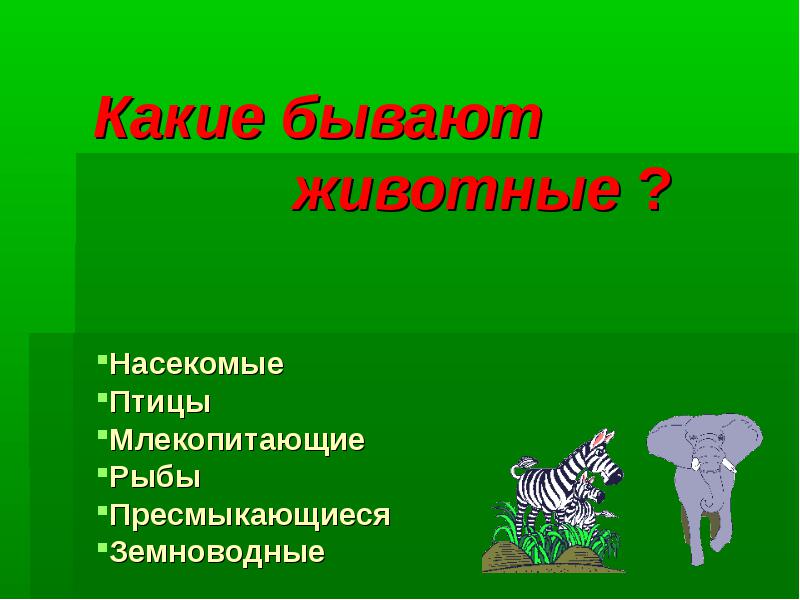
What types of animals are there? ?
Insects
Birds
Mammals
Fish
Reptiles
Amphibians
There are more insects than anything else in the world - 200,000 species.
Insects are animals that have
six legs (three pairs).
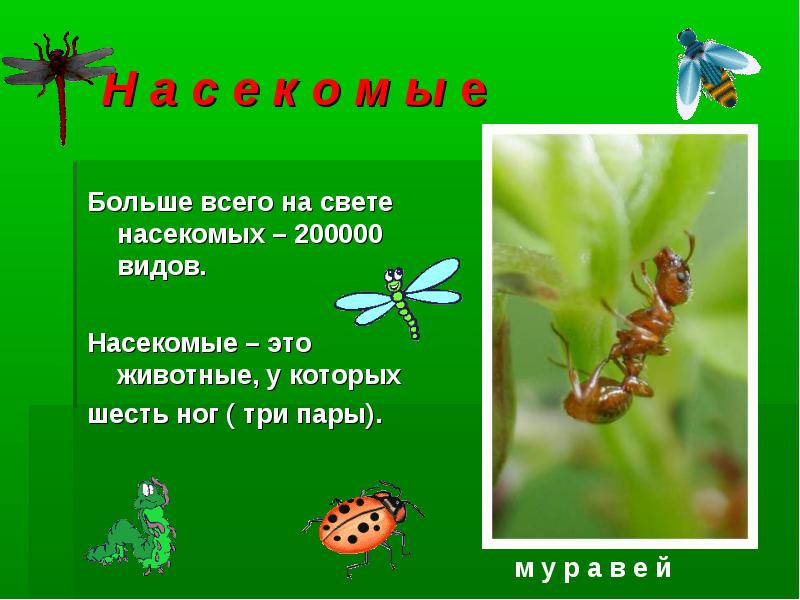
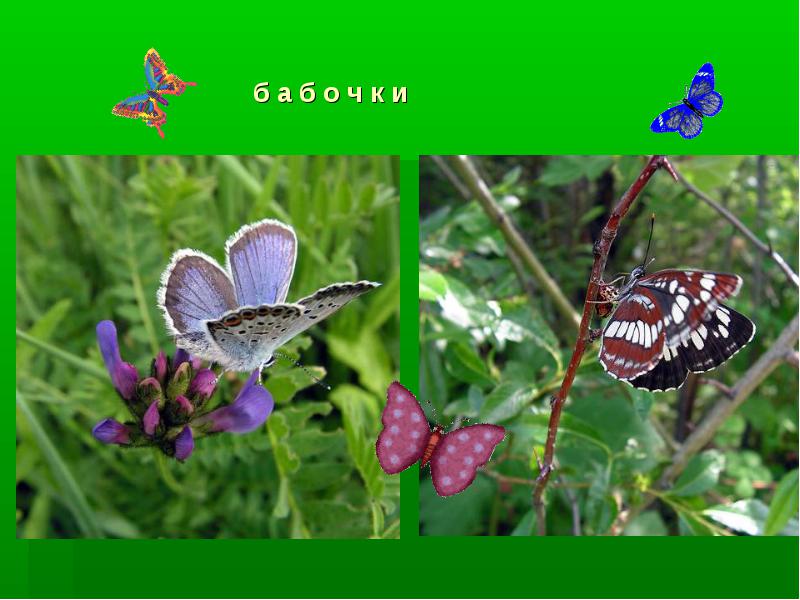
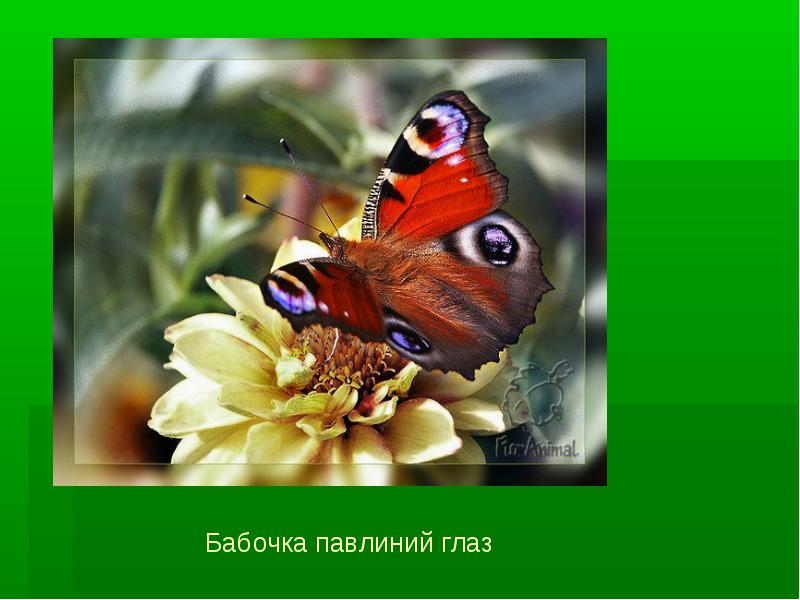
The bee brings nectar into the hive, from which it makes honey. And as a building material it uses wax secreted by the glands on the abdomen and propolis
(bee glue), which insects extract from plant buds.
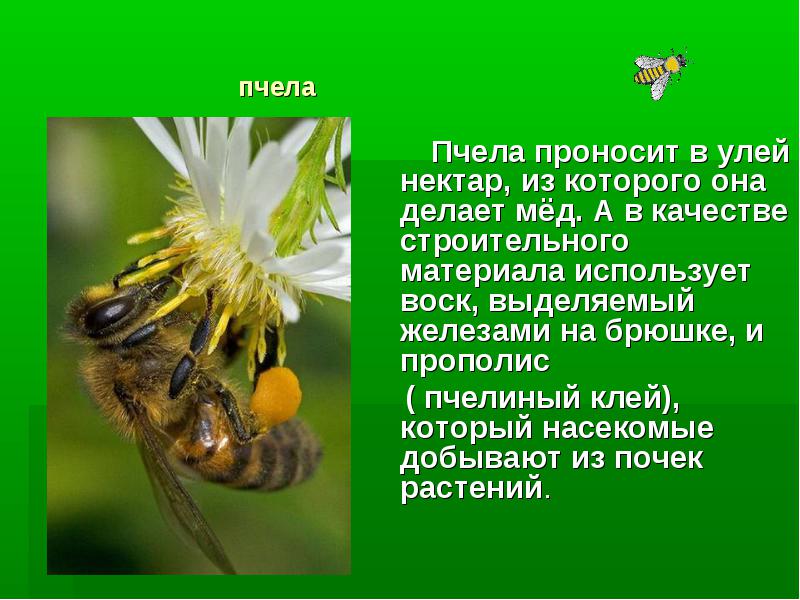
w u k i
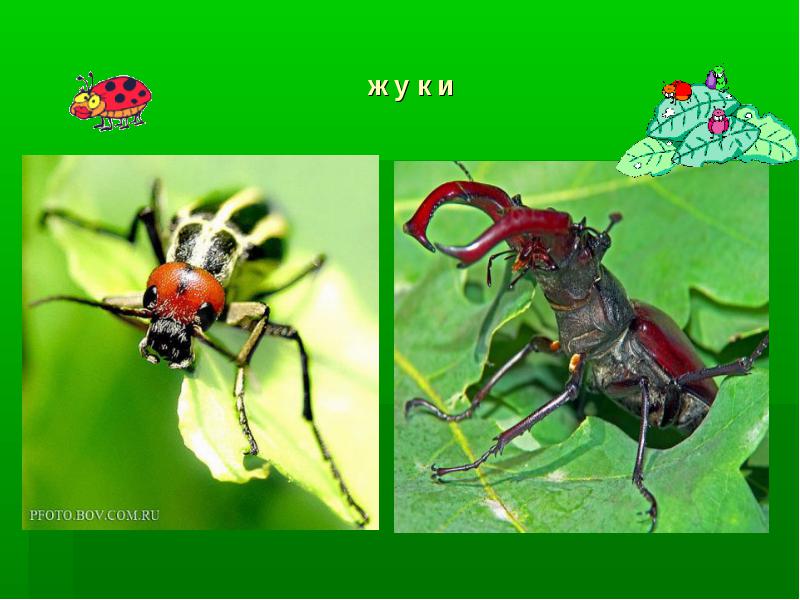
ladybug
They are called cows because they can secrete milk. It is not white, but orange.
In fact, this is not “milk”, but blood, acrid and unpleasantly smelling. Because of it, neither birds nor lizards eat cows. The cows are so brightly colored to warn the enemy: “We are inedible!” Don't touch!
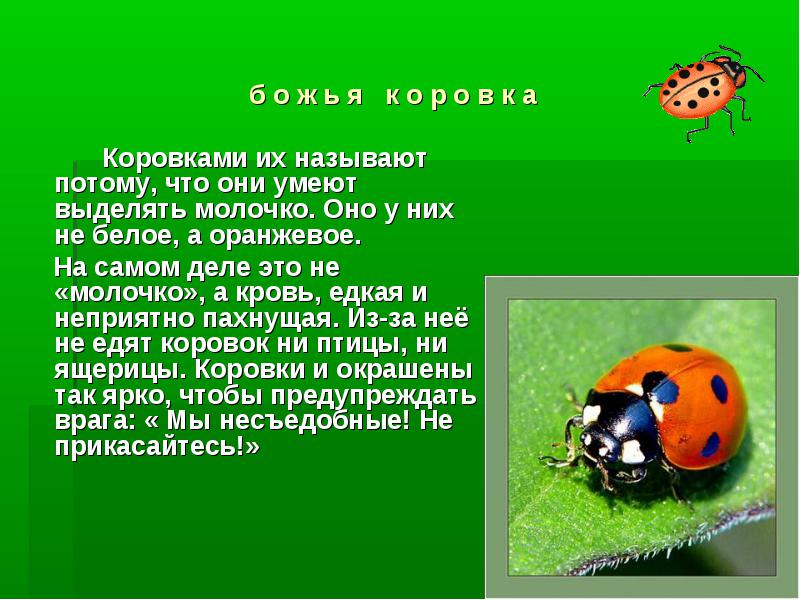
Grasshoppers have long legs, straight elytra, and females have “swords” or “sabers” at the back, with the help of which they lay eggs in the ground, in the stems of plants.
They “sing” using their wings and all have “ears” on their front legs. All grasshoppers jump well, pushing off with their legs, and descend slowly with the help of their wings.
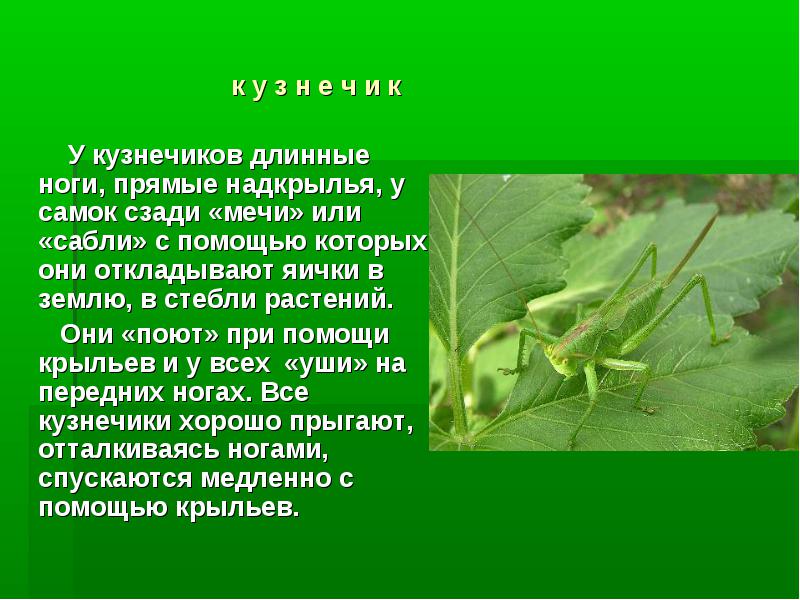
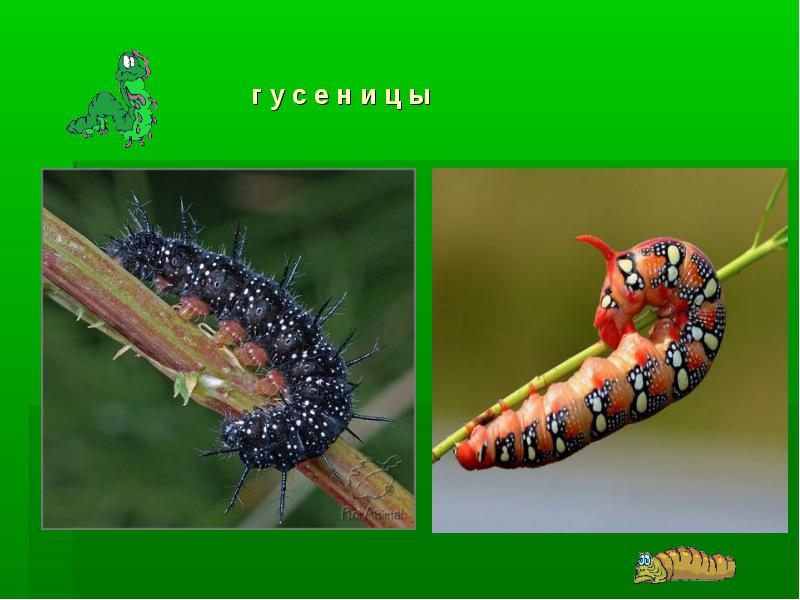
The most voracious predators on the planet. Their prey by weight
several times larger than the insect itself. They fly very fast. Most dragonflies have thirty thousand eyes, molded together on each side. The upper eyes distinguish only black and white colors, and the lower ones - all others.
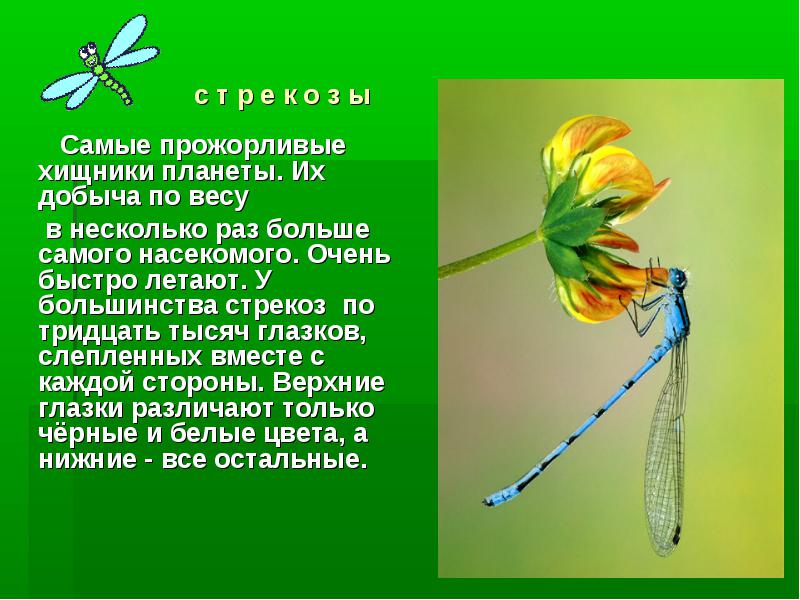
These insects can take off without a run and perform complex aerobatics, walk and crawl with the help of suction cups on their paws on any surface.
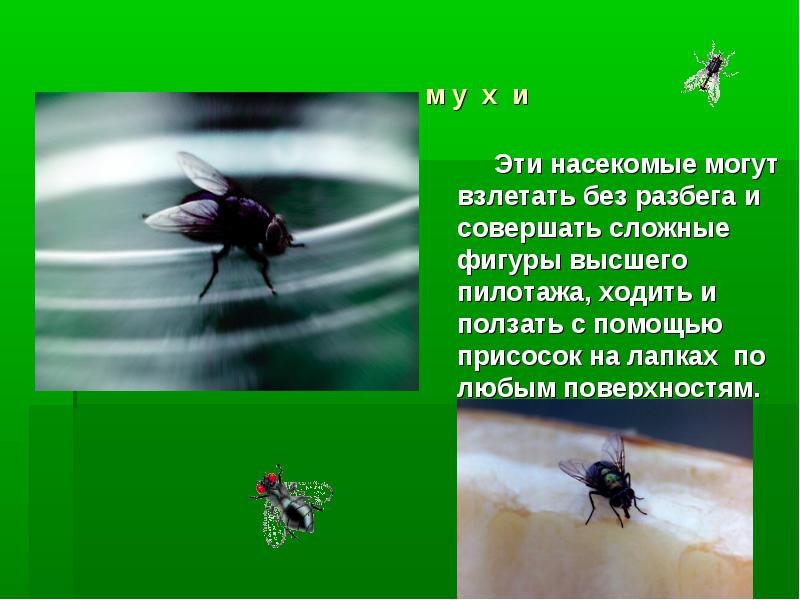
Birds are animals whose bodies are covered with feathers. There are about 9 thousand species of birds on earth. There are very big birds, and there are very small ones. Some fly above the clouds, while others don’t fly at all.
Some eat only fish, while others eat insects. Birds of prey eat other birds, and there are some that eat only berries and seeds.
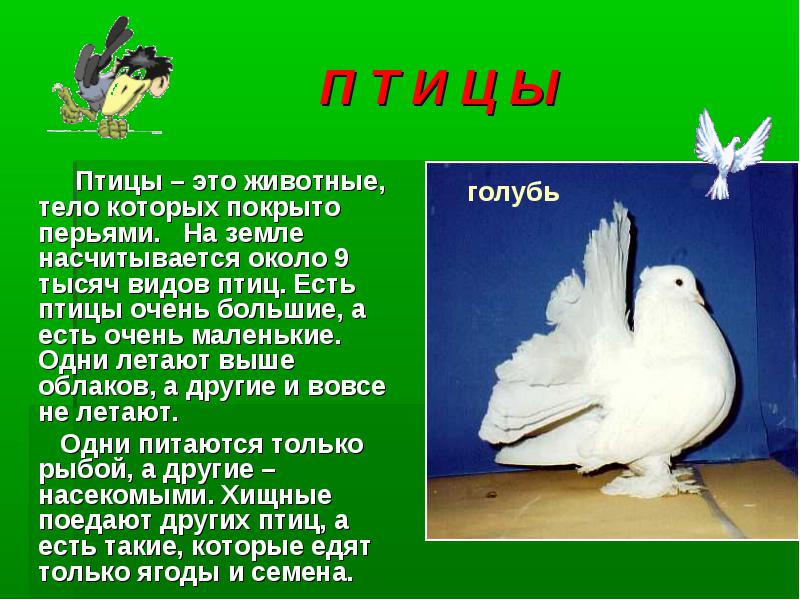
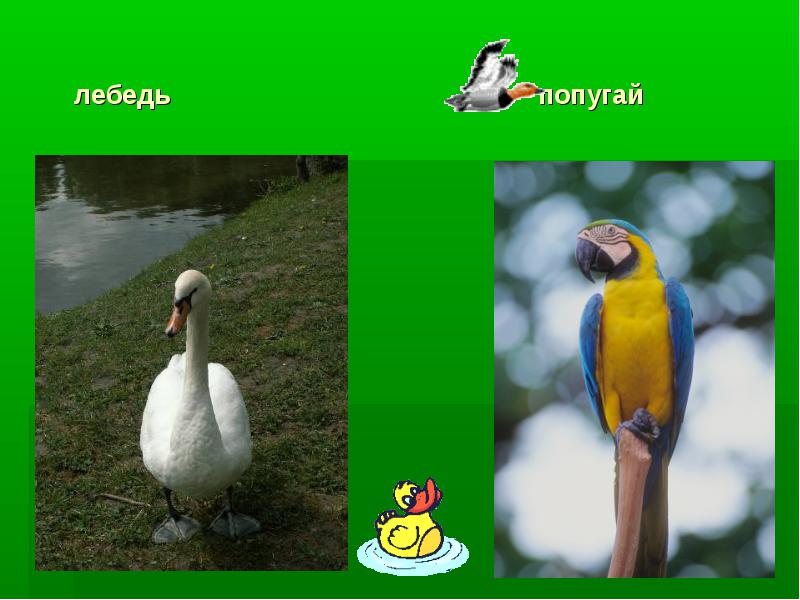
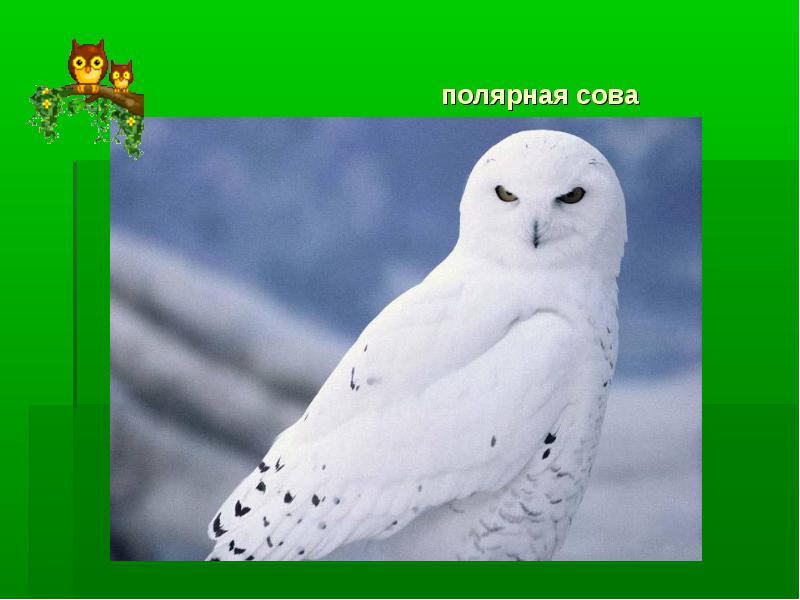
Mammals are animals whose bodies are covered with hair. They give birth to live young and feed them with milk.

The wolf has excellent eyesight, keen hearing, and amazing sense of smell.
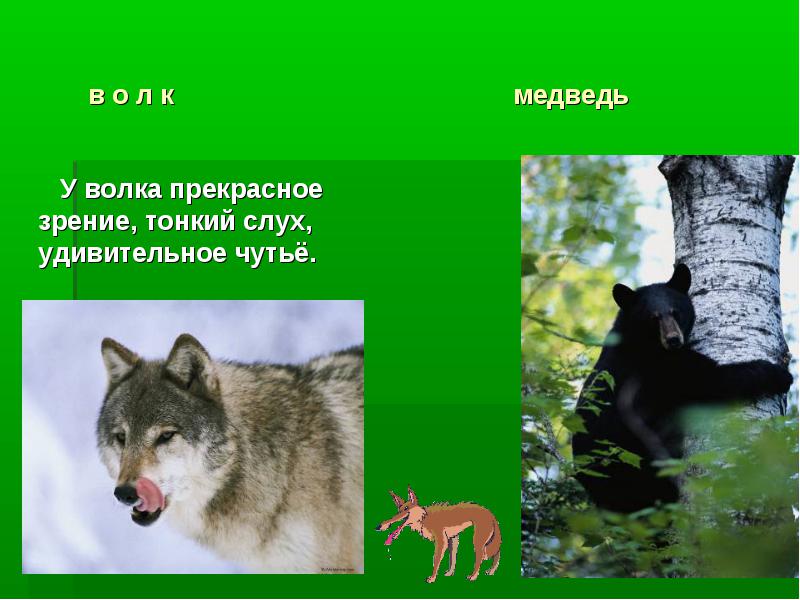
Fish are animals whose bodies are covered with slippery scales. Fish are aquatic inhabitants. Fins help them move. With the help of gills, fish breathe oxygen dissolved in water.
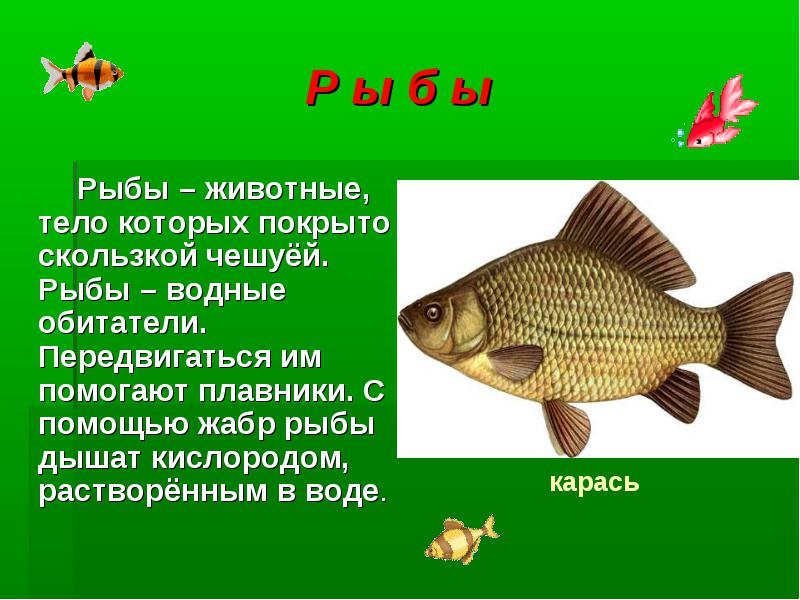
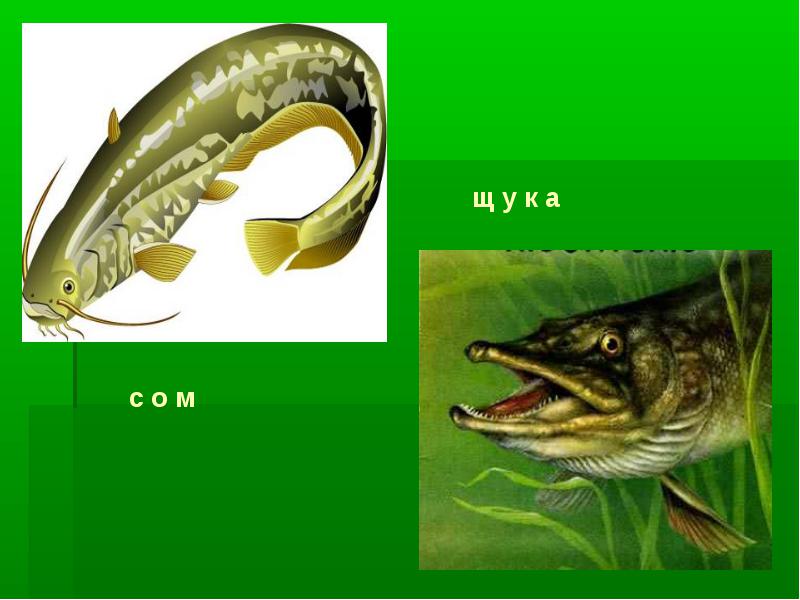
Reptiles are animals whose bodies are covered with dry scales, and some also have a shell. Reptiles include lizards, snakes, turtles, and crocodiles.

turtle
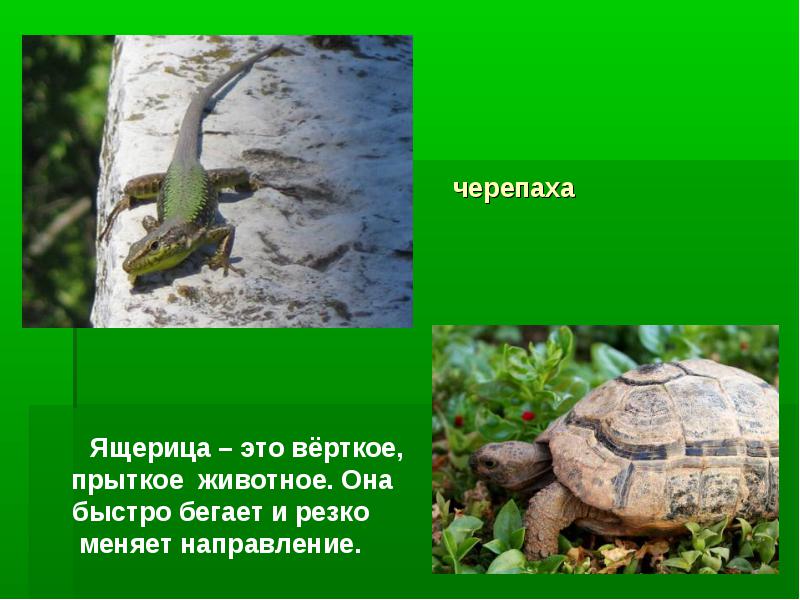
crocodiles
Crocodiles are one of the most ancient inhabitants of the planet.
Now there are 21 species of these huge reptiles living on earth. From their ancient ancestors they retained an affinity for hot climates and life in water. That is why they live only in tropical countries.
Crocodiles are excellent swimmers and excellent divers.
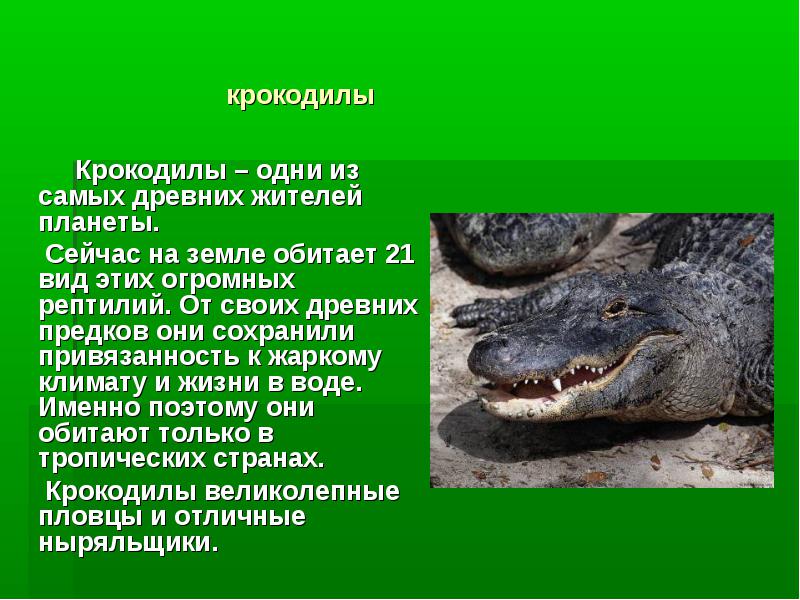
GROUNDWATERS
Amphibians are animals with bare, delicate skin. These include frogs and toads. They spend part of their life on land and part in water.
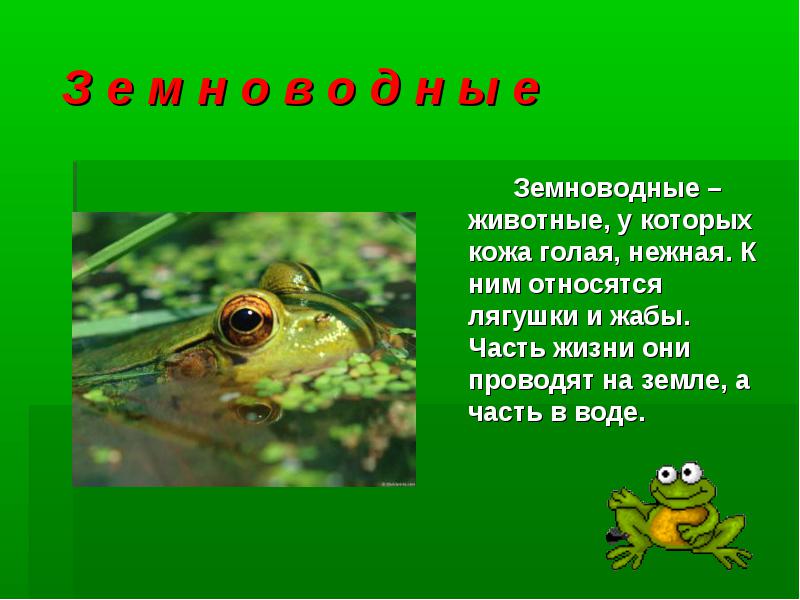
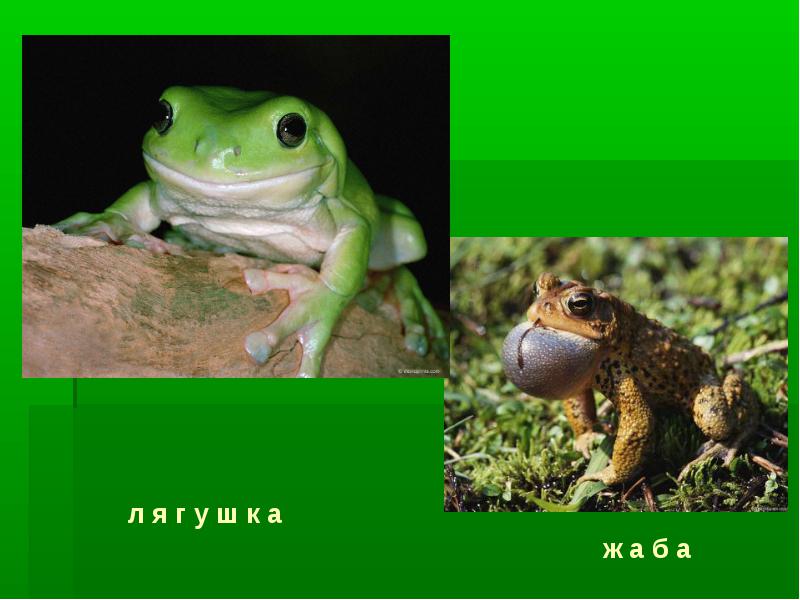
The most resilient animal is hydra
The most resilient animal is hydra: If you cut it, each piece will again become a hydra.
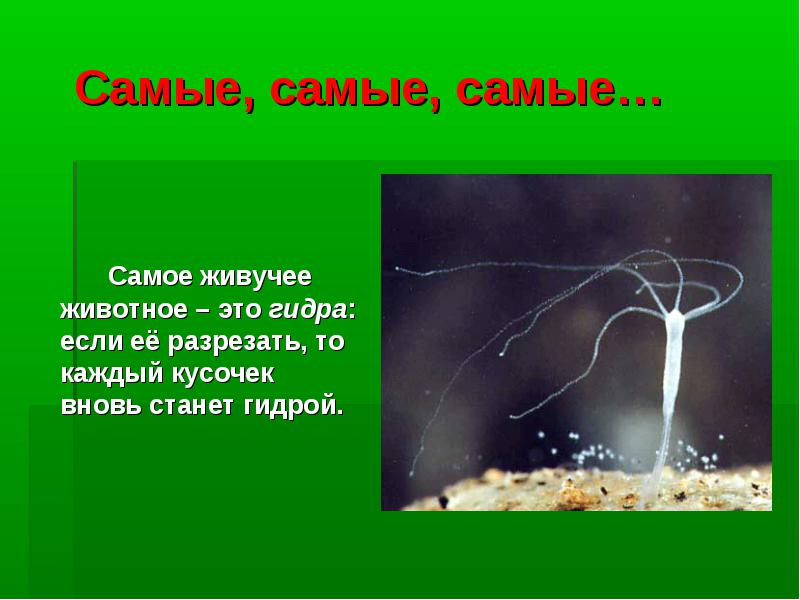
The most, the most, the most...
The largest day butterfly is a female Queen Alexandra's birdwing. Its wingspan reaches 26-28 cm. It lives on the island of New Guinea.

The most, the most, the most...
The heavyweight champion among insects is the African, clad in a massive shell. goliath beetle – weight 100 grams.
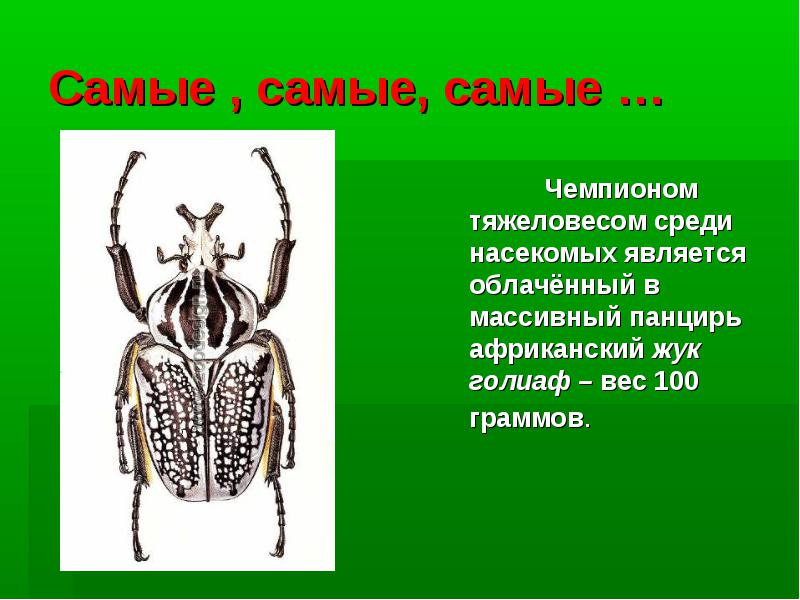
The most, the most, the most...
Fastest swimmers:
perch – 17 km/h; pike -
33 km/h; barracuda and
mackerel – 40 km/h.
The fastest is the swordfish.
She is an absolute champion in short-distance swimming and can reach speeds of up to 130 km/h.
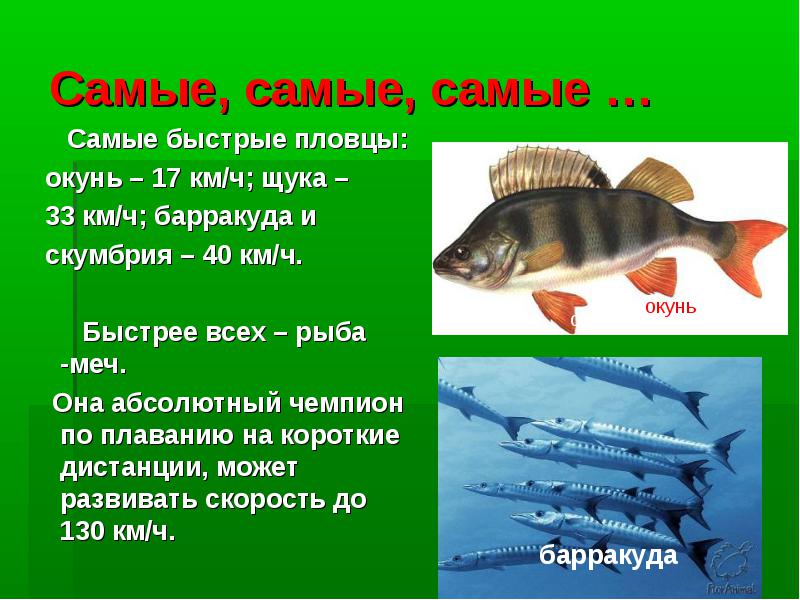
The most, the most, the most...
The deadliest-
king cobra . Her poison is deadly, and she attacks
always without delay.
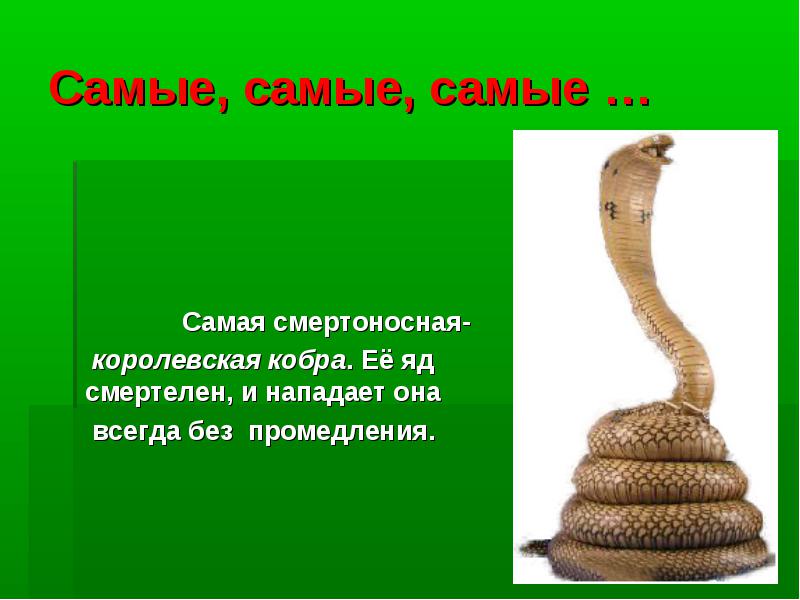
Lesson objectives: Introduce a new classification of animals and their group characteristics, broaden your horizons, teach friendly
group work, development of visual memory, accommodation, tracking functions of the eye.
Equipment: Schemes: “Wild and domestic animals”, “Classification of animals”; cards for individual work and work
in groups, silhouettes of animals in black.
Lesson progress
1. Psychological attitude . ( Smile at each other, guests and mentally wish everyone success.)
2. Preparation for the perception of new material.
Read the words, find the odd one out: elephant, spider, pineapple, stork
Which kingdom does it belong to? What do all the other words have in common?
There is a huge house on earth (read by student)
Under the roof is blue.
The sun, rain and thunder live in it,
Forest and sea surf.
Birds and flowers live in it,
The cheerful sound of the stream.
You live in that bright house
And all your friends.
Wherever the roads lead,
You will always be in it.
This house is called the nature of our native land.
3. Formulating the topic of the lesson.
– Let’s start our work in class with an intellectual moment. If you complete all the tasks correctly, then you will decide the topic of today’s lesson. From the two answer options, choose the correct one and circle the corresponding letter.
1) In which plant organ does the formation of nutrients occur?
l – root
h – leaves
2) When breathing, plants absorb:
o – oxygen
р – carbon dioxide
3) Which group of plants do not have organs; the whole plant is 1 organism?
o – algae
a – ferns
4) What nutrients do plant leaves provide?
e – mineral salts
l – sugar and starch
5) Which one gas do plants excrete when feeding when “the kitchen is running”?
o – oxygen
t – carbon dioxide
6) Under what conditions will the plant “kitchen” work?
g - in the light
o - at a certain temperature
7) Sweet flower juice, which gives the flower its aroma:
l – pollen
and – nectar
8) Science that studies plants:
I'm a nerd
y – biology
– Hand in the sheets of completed assignments for verification. Now we will choose the correct answers together. What word did you get?
Zoology.
– What does this word mean? Let's try to guess for ourselves.
How many of you have been to the zoo? What do they sell at the pet store? All these words have a common part “zoo”, which is translated as “animal”. And “logos” in translation means “science”.
Zoology is the science of animals.
State the topic of our lesson. “ Let's talk about the diversity of the animal world, the caring attitude of animals, and the science of animals.
And also today in the lesson we will talk about the groups into which animals are divided.
6. Work on the topic of the lesson.
– When you hear the word “animals,” who do you imagine?
– Each animal has its own habitat. Some live in water, some on land, others in soil, and the life of other animals is closely connected with air. And many live next to a person. What are the names of animals that live next to humans? (Domestic ones.) And those that live in the wild? (Wild.)
You were introduced to this classification in 2nd grade.
Work in groups.
– Each group has cards: cow, squirrel, elk, reindeer, chicken, bear, ram, cat, fox. Divide the animals into 2 groups.
– Animals can be divided not only into wild and domestic. Scientists divide the animal kingdom into a large number of groups. Today we will get to know some of them. In each group, animals are similar to each other in appearance and lifestyle. Here are the names of these groups. Some names are familiar to you, some you heard for the first time.
On the board: birds, fish, animals, insects, amphibians, reptiles.
Children are divided into 6 groups. Each group receives a riddle about a specific animal and prepares a description of the animal according to plan.
- Habitat.
- Covers of the body.
- Organs of locomotion.
- Reproduction.
- As they answer, each group determines which group or class this animal belongs to and attach a picture with its image to a table made on the board (insects, fish, amphibians, reptiles, birds, mammals).
I sent out messengers
I am waiting for guests from all over.
You guys don't rush
Help me recognize the guests.
1st group (bear). The body of these animals is covered with fur. They feed their young with milk. The body consists of a head, neck, torso, tail and four legs. The brain is well developed.
2nd group (fly). The largest group of animals. More than 1 million species are known. Their body consists of three parts: a head with two antennae, a chest and an abdomen. They have 6 legs. Most have wings and are able to fly.
3rd group (frog.) - That's right, these animals can live both in water and on land. Their skin is bare and tender. They don't have a neck. The large flat head immediately passes into the body. The hind legs are longer and stronger than the front legs. These animals are interesting because they breathe through their skin and lungs.
4th group (birds). No. 1. The body of these animals is covered with feathers. The body consists of a head, neck, torso, wings and two legs. Many of them are adapted for flight. They feed on insects.
5th group (viper). Representatives of this group of animals got their name from their method of movement. They crawl all the time, or one might say “creep.”
Their body is covered with dry scales or shell. Their body temperature depends on the air temperature, which is why many of them like to bask in the sun.
6th group ( fish.)
The body of these animals is compressed laterally and covered with slippery scales. They move by bending their body now to the right, now to the left. And their tail and fins help them with this. They breathe with the help of gills oxygen dissolved in water.
- Let's play a little. I name the animal, you put a cross next to the block.
Fly, turtle, nightingale, cat, perch, dragonfly, grass snake, crucian carp, cow. Everyone's habitat is different: ponds, deserts, forests.
A moment of rest.
– Sit in a way that is comfortable for you. Now we will have a little rest.
Eyelashes droop...
Eyes are closing...
You are resting peacefully... (2 times)
You fall asleep in a magical sleep...
Your hands are resting...
The legs also rest...
Resting... falling asleep... (2 times)
The neck is not tense and relaxed...
Breathe easily... freely... deeply...
(Long pause).2
You rested peacefully
We fell asleep in a magical sleep...
Have a good rest!
But it's time to get up!..
Clench your fists tighter,
Raise them higher...
Stretch!.. Smile!..
Everyone open their eyes and stand up!
(Children stand up and say the words in chorus)
- We are cheerful and vigorous again
And ready for classes!
And now you will get acquainted with another “Classification of Animals”.
There is a table diagram on the board.
– Who knows what the word “Fauna” means?
– All animals can be divided into two groups: unicellular and multicellular.
The group of unicellular organisms is not numerous; it includes “slipper ciliates” and “amoeba”.
Single-celled organisms are very small and can only be seen with a microscope.
The group of multicellular organisms is very large and diverse; it includes almost all living organisms living on Earth.
Multicellular animals are divided into two large groups: invertebrates and vertebrates. Presentation. (Slide)
– What animals do you think are invertebrates?
– Why do animals need a spine?
(Children's answers are listened to.)
It is concluded that the spine is necessary to maintain posture, move better, and for the functioning of the limbs.
The teacher uses a chart to introduce children to groups of animals.
Practical work.
– Now let’s look at the main characteristics of each group and fill out the table.
Children read the text in the textbook (from 88–89 “Diversity of Animals”), and collectively fill out the table on the board:
What kinds of animals are there?
| Groups of animals | Signs of the group |
| Invertebrate animals | |
| Worms: earthworm, leeches | |
| Shellfish: snails, slugs, octopuses, squids, cuttlefish | The soft body is usually protected by a shell |
| Echinoderms: starfish, sea urchins, sea lilies, sea cucumbers | There are needles |
| Crustaceans: crayfish, crabs, shrimp, woodlice | |
| Arachnids: scorpions, harvestmen, spiders, ticks | Have eight legs |
| Insects: beetles, butterflies, dragonflies, bees, flies | Have six legs |
| Vertebrates | |
| Fish | They live in water, their body is covered with scales, they move with the help of fins, they breathe with gills |
| Amphibians: frogs, toads, newts | Part of their life is spent on land, part in water. The skin is bare and tender. |
| Reptiles (reptiles): lizards, snakes, turtles, crocodiles | The body is covered with dry scales or shell |
| Birds | Body covered with feathers |
| Animals or mammals | The body is covered with fur. The cubs are fed milk. |
7. Lesson summary
– What groups of animals did you recognize? Name them. How are the representatives of each group different?
– What types can multicellular organisms be divided into?
– How are all animals related to each other?
“Reptiles” - Agile lizard. Features of the skeleton. Lizard skeleton. Reptiles. Amphibians. Squad Crocodiles. Turtle Squad. Fig. Petrova T. Squamate order. Suborder Lizards. Habitat. General characteristics reptiles. Method of transportation. Suborder Snakes. Class Reptiles (Reptiles). Comparison of the external structure and lifestyle of the sand lizard and the crested newt.
“Class of reptiles” - - What do a scuba diver and a frog have in common? Ear openings of lizards. External structure of a LIZARD. - What is the use of toads? - Why are frogs called amphibians? Pectoral, Lizard that recently lost its tail. What is the origin of reptiles? Squad Scaly. Yellow Tummy. Cover of a lizard's body. The brain is more complex than that of amphibians.
“Lesson on reptiles” - Develop logical, figurative and sensory thinking, creativity students. Introduction to the classification of reptiles. Classification and systematics of reptiles. Whoever swims towards them will swallow them all... An evil green steamer lives in the rivers of Africa! Game "Who's the odd one out?" On each line, cross out the name of the extra animal:
“Amphibians and reptiles” - Reptiles and amphibians. Amphibians. There is a subject index at the end of the book. There are species that permanently live in trees and are even capable of gliding flight. Information and bibliographic review grade 7. The book is equipped with a subject-name index. One of the chapters of the book talks about amphibians and reptiles.
“Structure of reptiles” - Order Crocodiles. Crocodiles. Lizards feed on insects. Various birds, small animals and snakes feed on lizards. Snakes are extremely tenacious creatures. They feed on insects. Lungs. Reproduction Lizards live in pairs. Later, the tail grows back and regenerates. This type of fertilization is called internal fertilization. Central Asian tortoise Far Eastern tortoise Mediterranean tortoise.
“Suborders of reptiles” - The patterned snake is a fairly fast and agile snake. Long-snouted whipweed. They breathe atmospheric air. Ovoviviparous. There is a long forked tongue in the mouth. Beakheads. The lizard is nimble - it runs quickly, jumps high and climbs branches well. Hatteria. Turtle. The laid eggs are buried in a hole.



